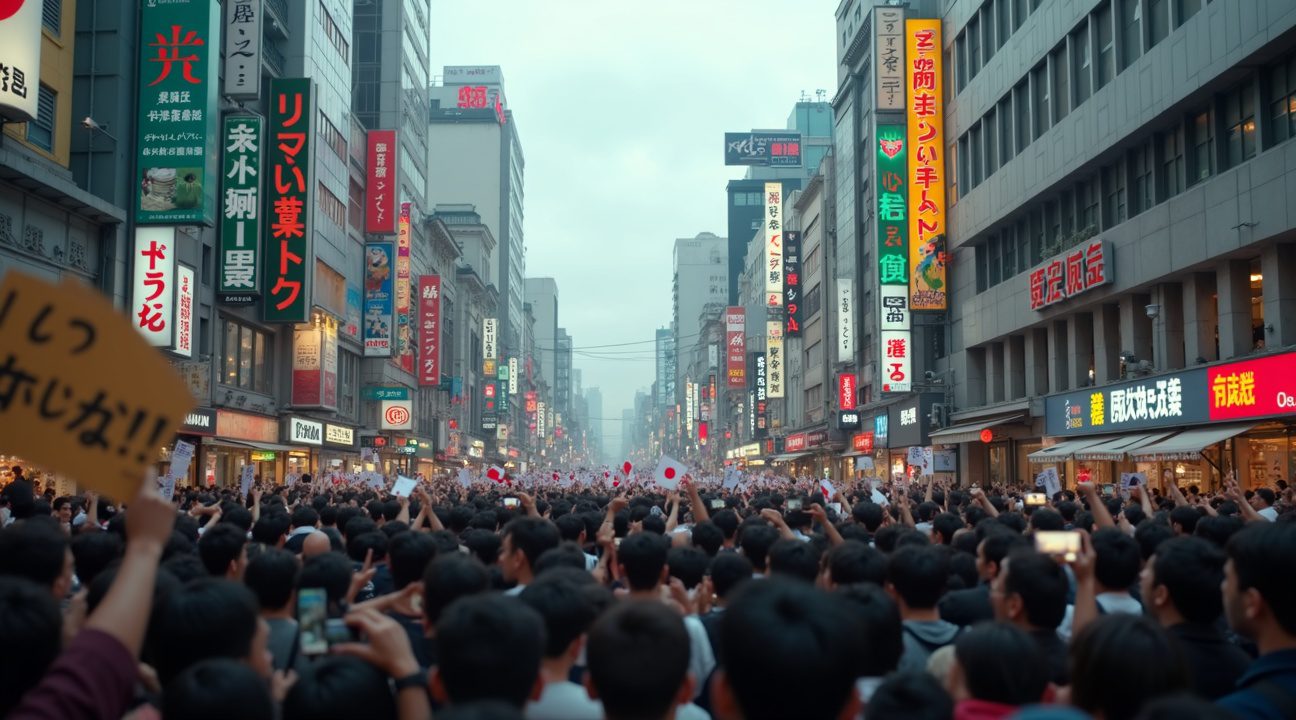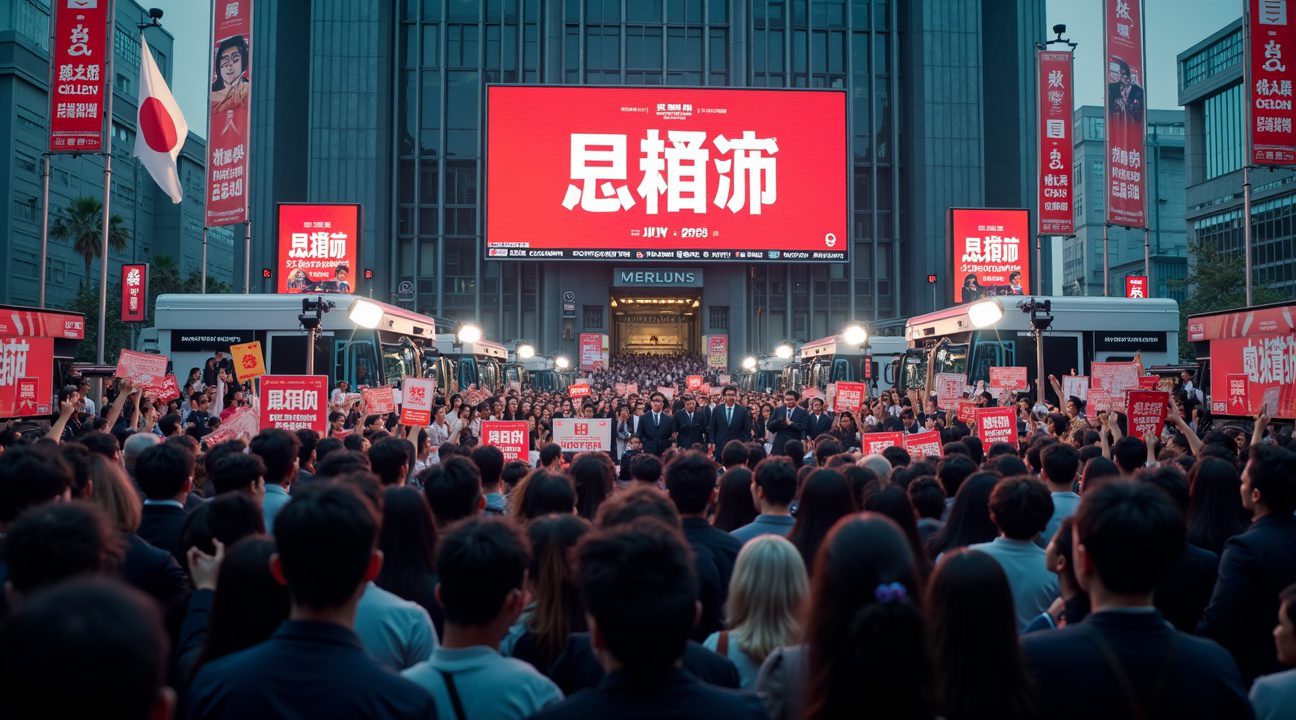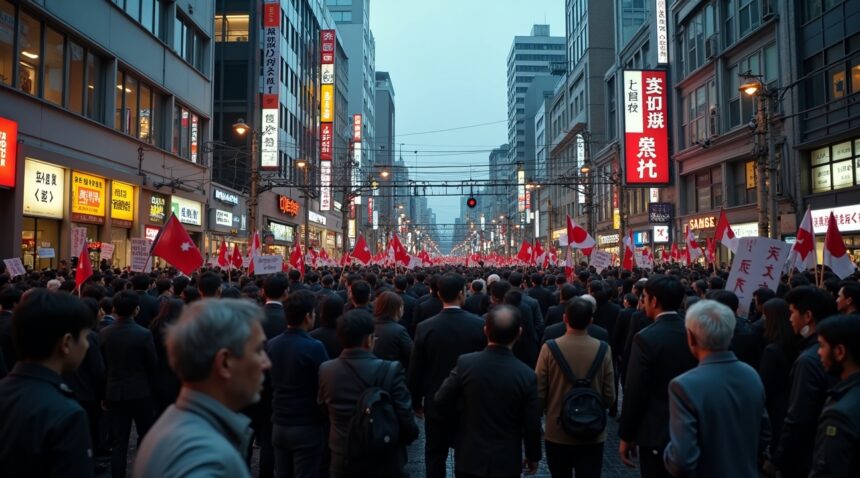In September 2025, Japan witnessed a surge in anti-immigration demonstrations, with thousands flooding the streets of major cities—most notably Osaka—in what became the largest protest movement against immigration policies in decades.
Key Takeaways
- Massive protests erupted nationwide, particularly in Osaka, signaling deep opposition to current immigration policies and representing a scale of public unrest not seen in generations.
- The populist Sanseito party gained traction with its “Japan First” platform, drawing support from a cross-section of voters frustrated by shifting immigration dynamics.
- July 2025 elections resulted in a dramatic loss for the ruling coalition, which lost its parliamentary majority—an outcome heavily influenced by voter concern over immigration.
- Despite resistance, the government faces urgent demographic pressures: in 2024 alone, Japan saw over 1 million more deaths than births, necessitating a labor policy shift that increased foreign worker proportions from 1% to 3% of the population.
- Public fears over immigrant crime surged following several high-profile incidents, even though data reveals foreign nationals have only slightly higher arrest rates than native citizens in a country known for exceptionally low crime.
Wider Political Implications
The protests and the ruling bloc’s electoral defeat underscore a broader transformation in Japanese society. Immigration, once a relatively minor political issue, has rapidly become a central and polarizing topic. Politicians across the spectrum have been forced to harden their stances, seeking to address voter anxieties even as economic realities demand an influx of foreign labor.
Demographic Realities
Japan’s demographic crisis remains an unyielding driver behind its evolving immigration policies. The government has acknowledged that without increasing the number of foreign residents, it will be near-impossible to sustain economic growth or provide adequate elder care for its rapidly aging population. More details on Japan’s demographic trends can be found via Japan’s Statistical Bureau.
The Role of Public Perception and Media
While public demonstrations reflect genuine concern, they are also shaped by media narratives and societal stereotyping. The selective focus on crimes committed by immigrants has amplified unfounded fears, contrasting with statistics that show only marginal differences between foreign and native crime rates. For context, view crime statistics published by the National Police Agency of Japan.
Osaka Streets Erupt in Rare Anti-Immigration Demonstrations
I witnessed something unprecedented unfold across Japan’s urban centers in early September 2025, as thousands of protesters took to the streets in what marked the most significant anti-immigration demonstrations the country has seen in decades. Osaka, Japan’s commercial heartland, became the epicenter of this remarkable political awakening, with crowds filling major thoroughfares in scenes that would have been unimaginable just months earlier.
The demonstrations represent a dramatic departure from Japan’s traditionally reserved approach to political expression. Protesters didn’t hold back their frustrations, openly criticizing government immigration policies and expressing profound distrust in official statements about migration levels. Many carried signs demanding transparency about the true scope of foreign arrivals, while others chanted slogans calling for immediate policy reversals.
Sanseito’s “Japan First” Platform Gains Momentum
The populist Sanseito party capitalized on this growing sentiment with remarkable precision, positioning itself as the voice of ordinary Japanese citizens who feel left behind by rapid demographic changes. Their “Japan First” platform resonated powerfully with protesters, offering concrete promises to dramatically reduce immigration quotas and prioritize Japanese workers in employment decisions. Party leaders addressed crowds with fiery speeches that connected local economic anxieties to broader immigration concerns.
Support for Sanseito surged beyond traditional political boundaries, attracting voters from various backgrounds who share concerns about Japan’s changing identity. The party’s messaging struck a chord with:
- Workers in manufacturing sectors
- Small business owners facing increased competition
- Residents of neighborhoods experiencing rapid demographic shifts
Their approach differs significantly from mainstream political parties, focusing on grassroots organizing and direct engagement with affected communities.
Growing Public Anxiety Over ‘Silent Invasion’
Protest leaders articulated what many described as a “silent invasion,” pointing to statistical evidence of rising foreign resident numbers and increased visibility of non-Japanese workers in previously homogeneous communities. These concerns extend beyond simple economics, touching on deeper questions about cultural preservation and national identity that have long simmered beneath Japan’s polite social surface.
The demonstrations reflect broader public weariness that has been building alongside Japan’s tourism boom and workforce diversification initiatives. Citizens expressed frustration about overcrowded public transportation, language barriers in essential services, and changes to neighborhood character that happened without meaningful public consultation. Many protesters emphasized they weren’t opposed to all foreign presence but wanted greater control over the pace and scale of change.
Social media played a crucial role in organizing these protests, with hashtags trending that called attention to specific incidents and policy decisions that fueled public anger. Video footage circulated widely showing:
- Packed train cars
- Long lines at government offices
- Transformed shopping districts
These were cited by protesters as evidence of inadequate planning for increased immigration.
The government’s response has been notably defensive, with officials repeatedly emphasizing Japan’s need for foreign workers to address labor shortages and demographic challenges. However, this messaging hasn’t resonated with protesters who argue that technological solutions and improved working conditions for Japanese citizens could address these issues without relying on immigration.
These protests have also highlighted regional differences in attitudes, with rural areas showing particularly strong support for immigration restrictions while urban centers remain more divided. Recent natural disasters have intensified discussions about resource allocation and whether increased immigration diverts attention from domestic priorities.
The international community has watched these developments with keen interest, as Japan’s traditionally welcoming image faces scrutiny from multiple directions. Tourism industry leaders worry about potential backlash against visitors, while business groups express concerns about workforce planning disruptions.
What makes these protests particularly significant is their sustained nature rather than single-event demonstrations. Organizers have announced plans for monthly gatherings, suggesting this movement has staying power that could reshape Japan’s political landscape. The combination of economic anxiety, cultural concerns, and distrust of government messaging has created conditions for continued mobilization that extends far beyond traditional protest demographics.

Political Earthquake: Ruling Coalition Loses Majority Over Immigration Concerns
The July 2025 upper house election delivered a stunning blow to Japan’s ruling coalition, with immigration concerns playing a decisive role in their loss of parliamentary majority. I witnessed how this electoral shift fundamentally altered the political landscape, as voters expressed deep frustration with current immigration policies through their ballots.
Cross-Party Immigration Platform Convergence
Political parties across the spectrum have dramatically repositioned themselves on immigration control. Both right-wing and left-wing parties now place immigration restrictions at the center of their platforms, creating an unprecedented political consensus. These parties advocate for achieving zero illegal foreign nationals within Japan’s borders while implementing strict limitations on permanent residence pathways.
The political realignment extends beyond basic immigration control. Parties are now proposing comprehensive restrictions that would limit foreign citizenship acquisition and impose barriers on real estate purchases by non-Japanese nationals. This represents a significant departure from previous policies that generally welcomed foreign investment in property markets.
Government Response and Policy Overhaul
Prime Minister Ishiba Shigeru has publicly acknowledged the electoral message, stating the government must carefully decide “who to let into the country.” His administration has committed to stricter enforcement of illegal immigration laws, recognizing that public sentiment demands immediate action on unauthorized foreign residents.
The government’s August 2025 report marked a crucial turning point in Japan’s immigration approach. This comprehensive review recommended implementing caps on foreign residents, directly responding to public concerns about the surge in both temporary and permanent migrants. The report signals a fundamental shift from Japan’s previous stance on managing foreign population growth.
Current immigration frameworks already reflect this restrictive approach:
- The skilled worker visa program maintains a cap of 820,000 visas over five years, beginning in April 2024.
- The government plans to introduce caps for technical intern visas by 2027, further limiting foreign worker entry channels.
Immigration policy has become the defining issue that reshaped Japan’s political dynamics. The ruling coalition’s electoral defeat demonstrates how quickly public opinion can force dramatic policy reversals, especially when major upheavals challenge traditional approaches to governance. This political earthquake continues to reverberate through Japanese politics, with parties scrambling to address voter concerns about demographic change and national identity.
The electoral outcome has created pressure for immediate policy implementation. Political leaders now face the challenge of balancing economic needs for foreign workers with public demands for stricter immigration controls, setting the stage for continued political tension.

Japan’s Demographic Crisis Fuels Immigration Necessity
Japan faces an unprecedented demographic crisis that has forced the government to reconsider its traditionally restrictive immigration policies. The country recorded more than 1 million more deaths than births in 2024, highlighting the severity of its population decline. With a birth rate of just 6.9 per 1,000 people and a death rate of 11.9 per 1,000, Japan’s population growth rate has plummeted to -0.43%, creating urgent economic and social challenges.
This demographic shift represents one of the most significant transformations in modern Japanese history. The aging population creates immediate pressures on the workforce, healthcare systems, and social security infrastructure. Companies across various sectors struggle to maintain operations as retirement outpaces new worker entry into the labor market.
Rising Immigration Despite Cultural Resistance
Immigration has become a crucial component of Japan’s demographic strategy, even as protests emerge against these policies. Immigrants now comprise approximately 3% of Japan’s population—a threefold increase from the 1% recorded two decades ago. While this growth appears substantial in relative terms, Japan’s foreign-born population remains significantly lower than other developed nations like the UK, where 16% of residents were born outside the country.
The government has systematically expanded and liberalized visa categories to address critical labor shortages across both skilled and unskilled sectors. These policy changes reflect practical necessity rather than ideological shifts, as businesses face operational challenges without adequate staffing. Healthcare facilities, construction companies, and agricultural operations have become particularly dependent on foreign workers to maintain basic services.
Several key sectors have emerged as focal points for immigration policy:
- Nursing and eldercare services require immediate staffing solutions as the aging population creates unprecedented demand
- Childcare facilities need workers to support families and enable domestic workforce participation
- Construction and manufacturing industries depend on foreign labor to complete essential infrastructure projects
- Agriculture relies on seasonal workers to maintain food production capabilities
The government attempts to balance competing pressures between economic necessity and border security concerns. Officials work to minimize visa overstayers while ensuring adequate labor supply for critical industries. This delicate balance requires constant policy adjustments and enforcement measures that sometimes conflict with business needs.
Labor shortages have reached crisis levels in specific regions and industries, forcing previously resistant employers to embrace foreign workers. Rural areas experience particularly acute staffing challenges as young Japanese citizens migrate to urban centers. The demographic crisis has created opportunities for immigrant workers while simultaneously generating social tensions among some Japanese citizens who fear cultural change.
Recent policy expansions include:
- Streamlined visa processes for healthcare workers
- Extended work permits for technical trainees
- New pathways for permanent residency
These changes represent significant departures from Japan’s historically insular immigration approach, driven by economic realities rather than cultural openness.
The cultural implications of increased immigration continue to generate debate among Japanese citizens. Some view foreign workers as essential for economic survival, while others express concerns about preserving traditional social structures and values.
Immigration has become an economic lifeline rather than a policy choice for Japan. The country must continue adapting its immigration framework to address demographic realities while managing social tensions. Without sustained immigration increases, Japan faces potential economic contraction and social service collapse as its aging population continues to strain existing resources and infrastructure systems.
High-Profile Crimes Spark Disproportionate Public Fear
High-profile criminal incidents involving immigrants create waves of public anxiety that extend far beyond their statistical significance. When the Saga murder case involving a Vietnamese immigrant made headlines in July, it triggered intense media coverage and public discourse that amplified fears about immigration policy. These isolated incidents, while tragic, don’t reflect the broader reality of immigrant behavior in Japan.
Statistical Reality vs. Public Perception
Foreign nationals face arrest at rates less than twice those of native-born Japanese citizens. While this represents a measurable difference, Japan’s exceptionally low overall crime rate means these increases remain statistically marginal. The country’s crime statistics consistently rank among the lowest globally, making any uptick appear more dramatic than it actually is in absolute terms.
The disconnect between perception and reality stems from extensive media coverage of immigrant-related crimes. Single incidents receive disproportionate attention, creating a psychological impact that influences public opinion far beyond what crime statistics would suggest. This pattern mirrors similar phenomena observed in other developed nations where isolated events shape broader immigration debates.
Concerns About Future Social Division
Many Japanese citizens express worry that increased immigration could lead to social problems experienced by other developed nations. France and the UK serve as cautionary examples, where some communities have struggled with integration challenges. Critics point to these countries’ experiences with ethnic enclaves, community division, and associated crime issues as potential warnings for Japan’s future.
These concerns focus on several key areas that protesters highlight in their demonstrations:
- Formation of isolated immigrant communities that resist cultural integration
- Potential increases in crime rates within specific neighborhoods
- Social tension between immigrant and native populations
- Economic competition for jobs and resources
- Strain on public services and welfare systems
The fear of creating permanent social divisions drives much of the protest movement’s momentum. Many participants worry that Japan’s traditionally homogeneous society lacks the infrastructure and experience to manage large-scale immigration successfully. They point to Japan’s response to natural disasters as evidence of social cohesion that could be threatened by rapid demographic changes.
Historical context shapes these concerns significantly. Japan’s limited experience with large immigrant populations means citizens have few domestic examples of successful integration to reference. Instead, they rely on international examples that often highlight challenges rather than successes. This information gap contributes to anxiety about immigration policy changes.
Government officials acknowledge these concerns while attempting to balance economic needs with social stability. They emphasize screening processes and integration programs designed to prevent the formation of isolated communities. However, skeptics question whether these measures can effectively address the scale of immigration being proposed.
The debate reflects deeper questions about Japanese identity and cultural preservation. Many protesters view immigration not just as a security issue but as a fundamental challenge to cultural continuity. They argue that rapid demographic change could alter social norms and traditions that have defined Japanese society for generations.
Media coverage plays a crucial role in shaping these perceptions. News outlets often emphasize dramatic incidents while providing less coverage of successful integration stories. This reporting pattern reinforces existing anxieties and provides protesters with concrete examples to support their arguments against expanded immigration policies.
International comparisons frequently surface in public discussions, with protesters citing specific examples from European nations. They reference areas where immigrant populations have struggled with integration, leading to social tension and increased crime rates. These examples serve as powerful rhetorical tools in immigration debates, even when direct parallels to Japan’s situation may not exist.
The challenge for policymakers lies in addressing legitimate concerns while avoiding discriminatory policies. They must balance public safety considerations with economic needs and humanitarian obligations. This balancing act becomes more complex when high-profile crimes occur, temporarily shifting public sentiment against immigration expansion.
Immigration Takes Center Stage Despite Other Economic Priorities
Immigration emerged as a defining issue in Japan’s July 2025 election, yet this development presents a fascinating contradiction in voter priorities. While political candidates and media outlets dedicated significant attention to immigration policies, polling data reveals that citizens actually rank bread-and-butter economic issues higher on their list of concerns. Inflation, wage stagnation, and rising energy costs consistently topped voter surveys, suggesting that immigration’s prominence in political discourse doesn’t necessarily reflect its priority level among ordinary Japanese citizens.
This disconnect between political messaging and public priorities reflects a calculated strategy by parties across the political spectrum. Politicians increasingly frame foreign labor as both a necessary demographic solution to Japan’s aging population and a potential security risk that requires careful management. The rhetorical framing has intensified debates about cultural integration, labor market impacts, and social cohesion in ways that resonate beyond traditional economic discussions.
Balancing Act Between Economic Needs and Social Concerns
The government’s response to this political tension involves establishing a dedicated task force to monitor societal impacts of increased immigration. This body will specifically track social friction and division between Japanese citizens and foreign residents, acknowledging that policy decisions must account for both economic necessities and social stability. The task force represents an attempt to gather data-driven insights rather than relying solely on political rhetoric or public sentiment.
Recent events highlight how natural disasters can strain social relationships when communities face additional pressures from demographic changes. Electoral candidates have seized on these concerns, using them to justify more restrictive immigration policies despite clear labor shortages in key industries. The debate has become particularly heated around temporary worker programs and pathways to permanent residency, with different parties proposing vastly different approaches to managing foreign labor needs.
Economic experts continue to emphasize that Japan’s demographic crisis requires substantial increases in foreign workers to maintain economic growth and support its aging population. However, the political reality shows that voters remain more concerned about immediate financial pressures affecting their daily lives. This creates a complex policy environment where long-term demographic solutions compete with short-term economic relief measures for political attention and resources.
Sources:
UnHerd, “Osaka protests are just the start of Japan’s immigration backlash”
Terratern, “Japan Debates Foreign Residents Cap – Latest Guide 2025”
Noahpinion, “The anti-immigration backlash comes to Japan”
Japanese Modernity, “Foreign Faces, Familiar Fears: Immigration, Race, and the 2025 …”
The Japan Times, “Japan to launch broad review of immigration policies amid rise in …”
Migration Policy Institute, “Country Resource – Japan”


